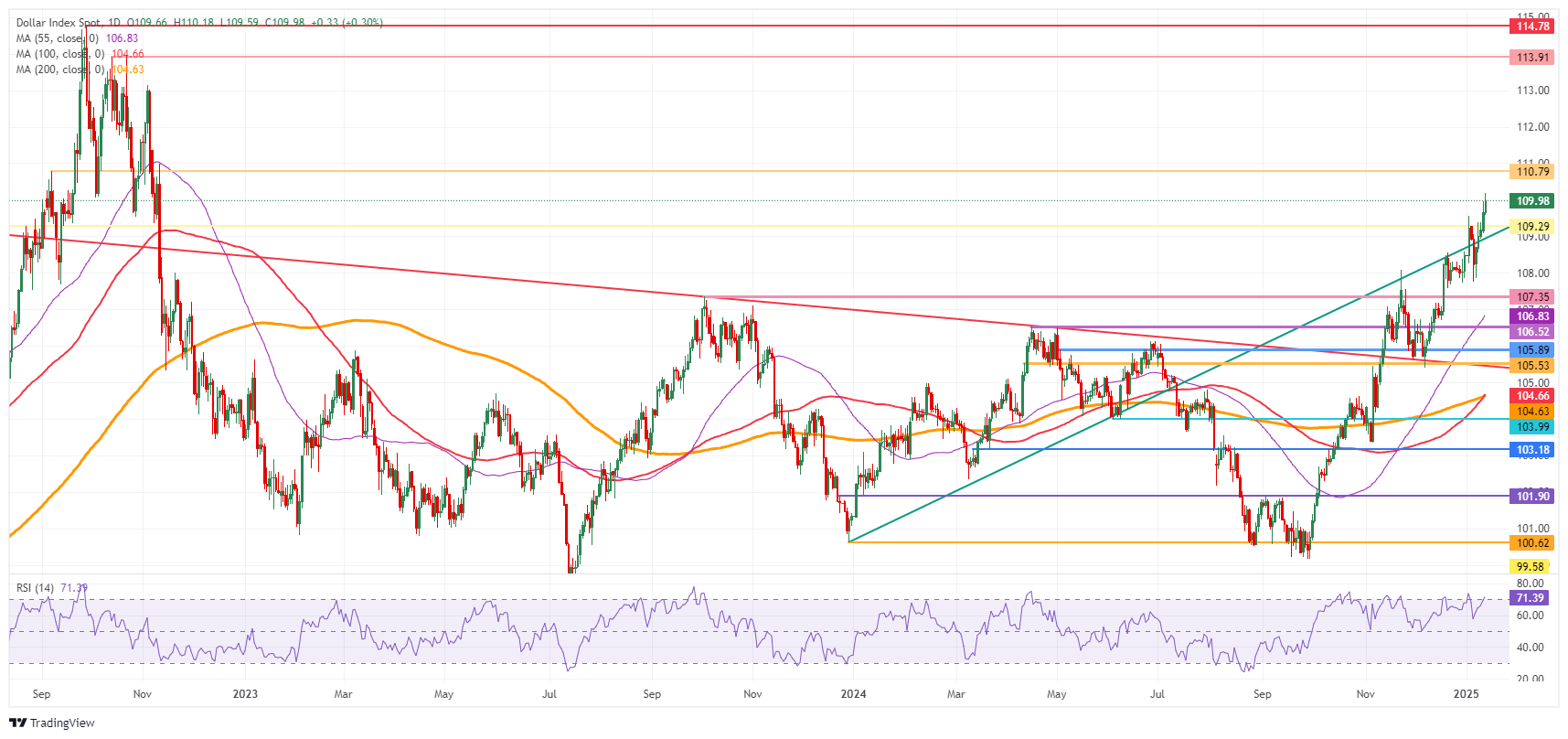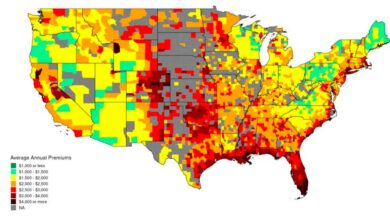US Dollar in the green, fueled by market rout

- The US Dollar ties up with gains for a fifth straight day against nearly every major G20 peer.
- Markets are rebalancing for a more restrictive Fed policy in 2025 after the most recent US employment report.
- The US Dollar Index (DXY) surges to 110.00, looking for consolidation at these upper levels.
The US Dollar Index (DXY), which tracks the Greenback’s value against six major currencies, is heading higher again, for the fifth straight day and orbits at levels not seen since November 2022, on Monday. The move comes after markets catch up with the recent Nonfarm Payrolls report for December, released on Friday, and adjusted to the new narrative that the Federal Reserve (Fed) would be more restrictive and keep rates steady for longer, with chances for several interest rate cuts in 2025 diminishing.
The US economic calendar is rather calm in the run-up to the Consumer Price Index (CPI) release on Wednesday and Retail Sales on Thursday. At least this Monday will be a very quiet start, with just a few smaller bond auctions on the agenda. Meanwhile, traders can assess their next moves ahead of President-elect Donald Trump’s inauguration next week.
Daily digest market movers: Equities are a concern
- At 16:30 GMT, the US Treasury will allocate a 3-month and a 6-month bill.
- At 19:00 GMT, the December Budget Statement will be released. The deficit is expected to shrink to $62 billion from $367 billion.
- Equities are dipping lower, dragged lower by Nvidia shares selling off. The rout comes after several major companies such as Microsoft have cancelled their large orders for Nvidia’s latest chip server racks.
- The CME FedWatch Tool projects a 97.3% chance that interest rates will be kept unchanged at current levels in the January meeting. Expectations are for the Federal Reserve (Fed) to remain data-dependent with uncertainties that could influence the inflation path once President-elect Donald Trump takes office on January 20.
- US yields are softening slightly. The 10-year benchmark is at 4.770%, off the fresh nine-month high of 4.798% seen in Asian trading on Monday.
US Dollar Index Technical Analysis: Inverse correlation
The US Dollar Index (DXY) is in the last seven days before President-elect Donald Trump takes office. With the changing market narrative towards a longer and more restrictive Fed monetary policy going forward, chances that the Fed might not even cut at all in 2025 could be very plausible. In that case, the ramifications for the Greenback would be that the US Dollar Index would surge even further.
On the upside, the 110.00 psychological barrier needs to be held, and a consolidation must be seen above it for the rally to move higher. Further up, 110.79 remains the next big upside level to hit. Once beyond there, it is quite a stretch to 113.91, the double top from October 2022.
On the downside, the first downside barrier is 107.35, which has now turned into support. The next level that might halt any selling pressure is 106.52, with the 55-day Simple Moving Average (SMA) at 106.83 reinforcing above this region of support.
US Dollar Index: Daily Chart
Interest rates FAQs
Interest rates are charged by financial institutions on loans to borrowers and are paid as interest to savers and depositors. They are influenced by base lending rates, which are set by central banks in response to changes in the economy. Central banks normally have a mandate to ensure price stability, which in most cases means targeting a core inflation rate of around 2%. If inflation falls below target the central bank may cut base lending rates, with a view to stimulating lending and boosting the economy. If inflation rises substantially above 2% it normally results in the central bank raising base lending rates in an attempt to lower inflation.
Higher interest rates generally help strengthen a country’s currency as they make it a more attractive place for global investors to park their money.
Higher interest rates overall weigh on the price of Gold because they increase the opportunity cost of holding Gold instead of investing in an interest-bearing asset or placing cash in the bank. If interest rates are high that usually pushes up the price of the US Dollar (USD), and since Gold is priced in Dollars, this has the effect of lowering the price of Gold.
The Fed funds rate is the overnight rate at which US banks lend to each other. It is the oft-quoted headline rate set by the Federal Reserve at its FOMC meetings. It is set as a range, for example 4.75%-5.00%, though the upper limit (in that case 5.00%) is the quoted figure. Market expectations for future Fed funds rate are tracked by the CME FedWatch tool, which shapes how many financial markets behave in anticipation of future Federal Reserve monetary policy decisions.
Information on these pages contains forward-looking statements that involve risks and uncertainties. Markets and instruments profiled on this page are for informational purposes only and should not in any way come across as a recommendation to buy or sell in these assets. You should do your own thorough research before making any investment decisions. FXStreet does not in any way guarantee that this information is free from mistakes, errors, or material misstatements. It also does not guarantee that this information is of a timely nature. Investing in Open Markets involves a great deal of risk, including the loss of all or a portion of your investment, as well as emotional distress. All risks, losses and costs associated with investing, including total loss of principal, are your responsibility. The views and opinions expressed in this article are those of the authors and do not necessarily reflect the official policy or position of FXStreet nor its advertisers. The author will not be held responsible for information that is found at the end of links posted on this page.
If not otherwise explicitly mentioned in the body of the article, at the time of writing, the author has no position in any stock mentioned in this article and no business relationship with any company mentioned. The author has not received compensation for writing this article, other than from FXStreet.
FXStreet and the author do not provide personalized recommendations. The author makes no representations as to the accuracy, completeness, or suitability of this information. FXStreet and the author will not be liable for any errors, omissions or any losses, injuries or damages arising from this information and its display or use. Errors and omissions excepted.
The author and FXStreet are not registered investment advisors and nothing in this article is intended to be investment advice.




